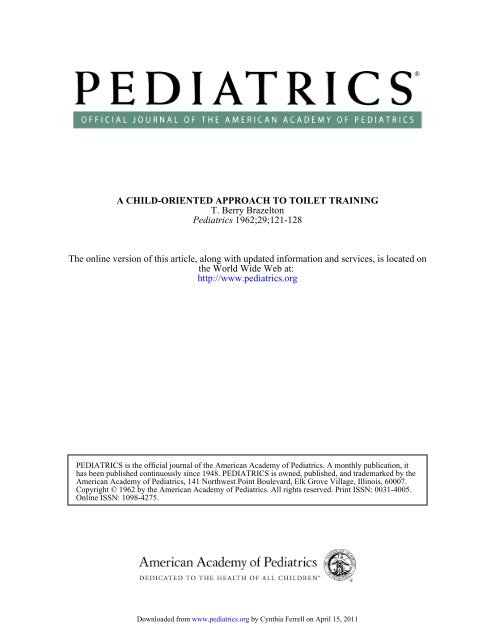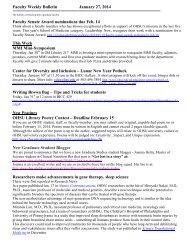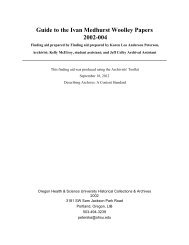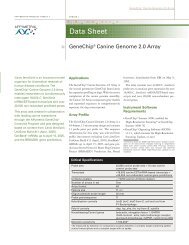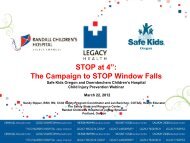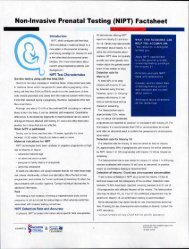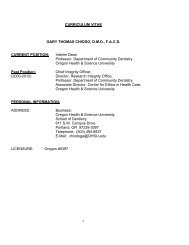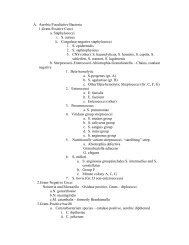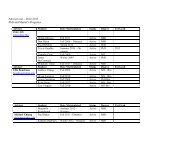1962;29;121-128 Pediatrics T. Berry Brazelton A CHILD-ORIENTED ...
1962;29;121-128 Pediatrics T. Berry Brazelton A CHILD-ORIENTED ...
1962;29;121-128 Pediatrics T. Berry Brazelton A CHILD-ORIENTED ...
You also want an ePaper? Increase the reach of your titles
YUMPU automatically turns print PDFs into web optimized ePapers that Google loves.
A <strong>CHILD</strong>-<strong>ORIENTED</strong> APPROACH TO TOILET TRAINING<br />
T. <strong>Berry</strong> <strong>Brazelton</strong><br />
<strong>Pediatrics</strong> <strong>1962</strong>;<strong>29</strong>;<strong>121</strong>-<strong>128</strong><br />
The online version of this article, along with updated information and services, is located on<br />
the World Wide Web at:<br />
http://www.pediatrics.org<br />
PEDIATRICS is the official journal of the American Academy of <strong>Pediatrics</strong>. A monthly publication, it<br />
has been published continuously since 1948. PEDIATRICS is owned, published, and trademarked by the<br />
American Academy of <strong>Pediatrics</strong>, 141 Northwest Point Boulevard, Elk Grove Village, Illinois, 60007.<br />
Copyright © <strong>1962</strong> by the American Academy of <strong>Pediatrics</strong>. All rights reserved. Print ISSN: 0031-4005.<br />
Online ISSN: 1098-4275.<br />
Downloaded from<br />
www.pediatrics.org by Cynthia Ferrell on April 15, 2011
A <strong>CHILD</strong>-<strong>ORIENTED</strong>APPROACH TO TOILET TRAINING<br />
T. <strong>Berry</strong> <strong>Brazelton</strong>, M.D.<br />
Department of <strong>Pediatrics</strong>, Harvard Medical School, and the Massachusetts General Hospital<br />
and the Children's Medical Center<br />
P EDIATRICIANShave a unique opportunity<br />
to prevent problems for the child in the<br />
area of bowel and bladder control. Since<br />
the advent of streamlined diaper care has<br />
liberated mothers in our culture from the<br />
real need to “¿train†their children early,<br />
this step may be viewed more honestly as<br />
a major developmental task for the child.<br />
Proper timing of this may enable him to<br />
achieve mastery for himself. The ultimate<br />
value of such self-achievement can be<br />
easily weighed against the adverse effects<br />
of inopportune training by an adult so<br />
ciety. The pediatric and psychiatric litera<br />
hire reports complications resulting from<br />
adverse toilet training.1'2 This paper will<br />
present the results of a program for train<br />
ing in which utilizing the child's develop<br />
mental capacities and interest was the pri<br />
mary goal.<br />
Parents and pediatricians are aware that<br />
the child's autonomous achievement in any<br />
developmental area frees him to progress<br />
to more advanced areas. Faulty mastery<br />
may leave him with a deficit that results in<br />
regression under stress. The relationship<br />
of coercive toilet training to chronic con<br />
stipation has been pointed out.7 Garrard<br />
and 411 presented six cases of<br />
functional megacolon with psychogenic<br />
etiology, in which the environmental pres<br />
sure expressed in training practices were a<br />
primary factor. Glicklich5 summarized psy<br />
chogenic factors in enuresis. Encopre<br />
sis2'4'9'1' and urinary incontinenc&â€3'14 can<br />
be traced to adverse or punitive training<br />
practices. Such pathologic symptoms usu<br />
ally reflect a fundamental psychologic dis<br />
turbance in the child's adjustment. But in<br />
healthful situations, parents can be encour<br />
aged to produce a positive reaction in the<br />
child to his control of bowel and bladder.<br />
This paper will outline a child-oriented<br />
approach to “¿toilet training†at around 2<br />
years, geared to each child's developmental<br />
capacities. The results from 1,170 children<br />
in 10 years of pediatric practice, for whom<br />
this<br />
ized.<br />
program was suggested, are summar<br />
THEORY<br />
The method suggested was constructed<br />
on several assumptions based on observa<br />
tions of physical and emotional maturation<br />
in children.<br />
Voluntary Control of Sphincters<br />
Local conditioning of reflex sphincter<br />
control can be effectively elicited as early<br />
as 9 months and has been the basis for an<br />
early introduction of<br />
co-operation may be elicited as early as<br />
12 to 15 months, and this period has been<br />
@ Voluntary<br />
ADDRESS: (Office) 51 Brattle Steet, Cambridge 38, Massachusetts.<br />
<strong>121</strong><br />
79, 12, 15 as optimal for training.<br />
However, myelinization of pyramidal tracts<br />
to these areas is not completed until the<br />
twelfth to eighteenth month.16 Associated<br />
with the transition from reflex compliance to<br />
a more voluntary type of developmental ac<br />
complishment, there is usually a perceptible<br />
time lag. In this period there is a kind of<br />
subtle inner resistance to outside pressure<br />
on the part of the child. This may be seen<br />
in many other developmental areas, such<br />
as reflex standing at 5 months to voluntary<br />
standing at 10 months, and vocalizations in<br />
the first year to verbal expressions in the<br />
latter half of the second year. This period<br />
is probably an important period of incor<br />
poration and of gathering inner forces for<br />
the child. In a complex area such as toilet<br />
training, it would be even more likely that<br />
any training based on early reflex compli<br />
ance would go through a subsequent period<br />
Downloaded from<br />
www.pediatrics.org by Cynthia Ferrell on April 15, 2011
122 TOILET TRAINING<br />
of bag and breakdown before voluntary<br />
compliance<br />
ensue.<br />
on the part of the child could<br />
Postponed breakdown in a control<br />
achieved before 12 to 18 months is much<br />
more frequent than that seen when con<br />
Other aspects of motor development<br />
participate in the ease with which a child<br />
achieves training. He must be abbe to sit<br />
and to walk in order to maintain some de<br />
gree of autonomy about leaving the potty<br />
chair, and some understanding of verbal<br />
communication is a help.<br />
The developmental energy invested in<br />
learning to walk on his own is freed after<br />
15 to 18 months and can be transferred to<br />
the more complex mastery of sphincter con<br />
trol and toilet training.<br />
Impulse Control<br />
There must be a psychologic readiness<br />
associated with a desire to control the fin<br />
pulses to defecate and urinate. These fin<br />
pulses are associated with a kind of primi<br />
tive pleasure and an immediacy. The reali<br />
zation of and wish to control them is de<br />
pendent on influences from the environ<br />
ment. Chief among them are 1) security<br />
and gratification in the relationship with<br />
parent figures, resulting in a desire to please<br />
them; 2) the wish to identify with and imi<br />
tate his parents and other important fig<br />
ures in his environment; and 3) the wish<br />
to develop autonomy and mastery of him<br />
self and his primitive impulses.8@17,21,22<br />
These psychobogic processes come to the fore<br />
in the latter half of the second year and ap<br />
pear to reach a peak of readiness in most<br />
children beginning at 18 months and in<br />
creasing to 30 months.<br />
trol is accomplished after 18 months.7' “¿ 20 Other Psychologic Processes<br />
That this breakdown in control can be cir At about 2 years of age there is a period<br />
cumvented by pressure from the environ in most children in our culture that is<br />
ment is easy to see in some European cub characterized by organizing and setting<br />
tures, where the incidence of postponed things in their proper places. Even a trend<br />
breakdown is much lower than in our own toward personal cleanliness may develop.<br />
less rigid 24,19However the sever These trends are useful in understanding a<br />
ity and intractability of the symptoms pro readiness for toilet training.<br />
duced in the deviant cases in these coun There is an ebb and flow of negativism in<br />
tries is good evidence for the strength of this period of development, and it must be<br />
the child's inner resistances, which bring accounted for in urging new accomplish<br />
about such breakdowns. The incidence of ments. As it is difficult for a parent or<br />
failure in England is reported as varying physician to evaluate the degree of nega<br />
from 10 to 15%.2,13<br />
tivism that is active at any particular time,<br />
Motor Adjuncts to Training<br />
it is necessary to pace<br />
slowly and with enough<br />
any such<br />
elasticity<br />
program<br />
to allow<br />
for these subtle variations.<br />
PARENTAL INVOLVEMENT<br />
Sears et al.18 pointed to many of the com<br />
plexities of parental feelings about toilet<br />
training in our culture. The child's ability<br />
to learn by imitation is complicated by<br />
taboos centered around modesty and the<br />
sexual feelings of the parents. For parents<br />
who wanted to train their children early<br />
in order to avoid such complex areas as<br />
1) sexuality, 2) cultural pressure from older<br />
generations, or 3) strong compulsive feel<br />
ings about cleanliness, pressure to delay<br />
training increased the parents' anxieties.<br />
They found, however, that many of their<br />
group of young parents were “¿in transit<br />
between old and new theories†(p. 109)<br />
and were in conflict about the age at which<br />
training might best be instituted. The<br />
“¿new†theories12'20 suggested waiting for the<br />
child's readiness. In the group who were<br />
able to postpone training, less time was<br />
required to complete it. But Sears et al.<br />
wondered whether parents who were<br />
pushed to delay against their wishes might<br />
not increase the tension around this area<br />
for the child.<br />
We have found that a “¿child-orientedâ€<br />
Downloaded from<br />
www.pediatrics.org by Cynthia Ferrell on April 15, 2011
approach in the group of parents in our<br />
study could divert some of their own an<br />
xiety, provided there was the “¿guiding earâ€<br />
of a third person, such as the pediatrician.<br />
The conviction that this was “¿better for the<br />
child†undoubtedly acted as a counter<br />
balance to the older cultural influences, as<br />
well as to their own sexuabized taboos in<br />
this area. Since the child's autonomous<br />
achievement was constantly the focus,<br />
there was the implication that there was<br />
less parental responsibility for failure in<br />
the child's lack of accomplishment. Ten<br />
sion could be reduced by airing parental<br />
conflicts and by assurance that the child<br />
would achieve control in his own time.<br />
PROCEDURE<br />
Advice was geared to each individual<br />
situation. At the 9-month visit the question<br />
of future toilet training was raised with the<br />
parents. Because the grandparents' genera<br />
tion usually began to press them at this<br />
time, it has proven to be an optimal period<br />
for the discussion of future plans in this<br />
area. With a program planned, the parents<br />
were better able to withstand outside pres<br />
sure to institute an early attempt at train<br />
ing the child.<br />
Before suggestions were introduced, the<br />
parents' own feelings in this highly-charged<br />
area were explored. A repeated opportunity<br />
for them to express their own resistances<br />
and anxieties about toilet training was fin<br />
portant in preventing their expressing them<br />
unconsciously to the child. The importance<br />
of a relaxed, unpressured approach to train<br />
ing for the child was constantly stressed.<br />
This method was presented as an adjunct<br />
to helping the child meet society's demands<br />
in this area. Because there is little innate<br />
in the child that leads him to want to be<br />
clean and dry, it must be understood as a<br />
kind of compliance to external pressure.<br />
The act of giving up the instinctual method<br />
of wetting and soiling to comply is evidence<br />
of 1) healthy maturation in the child,<br />
coupled with 2) a wish to identify with an<br />
adult society.17 Hence the optimal timing<br />
for such pressure must be geared to each<br />
child's physical and psychological readiness<br />
ARTICLES 123<br />
to cooperate. With his autonomous achieve<br />
ment of this major task, the reward for him<br />
is equivalent to that seen with his mastery<br />
of standing and walking and becomes a<br />
valuable step in his developmental prog<br />
ress. The danger of residual symptoms is<br />
then at a minimum.<br />
The importance of timing the introduc<br />
tion of this method to the child's readiness,<br />
and of allowing him freedom to master<br />
each step at his own pace, was reiterated<br />
at each subsequent visit. Problems with<br />
the child and resistances or questions from<br />
the parent were discussed at each oppor<br />
tunity. Since this was not necessarily an<br />
attempt to prejudice parents for this par<br />
ticular approach to toilet training, every<br />
effort was made to help them with their<br />
own method. However, when problems<br />
arose, the child's interests were placed fore<br />
most in the discussion.<br />
Method of Training<br />
At some time after the child is 18 months<br />
of age, a “¿potty chairâ€on the floor is intro<br />
duced as the child's “¿own chair.†During<br />
the period of getting familiar with it, as<br />
sociation between it and the parents' toilet<br />
seat is made verbally. At some routine<br />
time, the mother takes him each day to sit<br />
on his chair in all his clothes. Otherwise,<br />
the unfamiliar feeling of a cold seat can<br />
interfere with any further co-operation. At<br />
this time, she sits with him, reads to him or<br />
gives him a cookie. Since he is sitting on a<br />
chair on the floor, he is free to leave at<br />
will. There should never be any coercion<br />
or pressure to remain.<br />
After a week or more of his co-operation<br />
in this part of the venture, he can be taken<br />
for another period with hia diapers off, to<br />
sit on the chair as the routine. Still no at<br />
tempt to “¿catch†his stool or urine is made.<br />
“¿Catching†his stool at this point can<br />
frighten him and result in his “¿holding<br />
backâ€for a longer period thereafter. This<br />
gradual introduction of the routine is made<br />
to avoid setting up fears of strangeness and<br />
of loss of “¿part of himself.â€<br />
When his interest in these steps is<br />
achieved, he can be taken to his pot a sec<br />
Downloaded from<br />
www.pediatrics.org by Cynthia Ferrell on April 15, 2011
124 TOILET TRAINING<br />
ond time during the day. This can be after<br />
his diapers are soiled, to change him on<br />
the seat, dropping his dirty diaper under<br />
him into the pot, and pointing out to him<br />
that<br />
chair.<br />
this is the eventual function of his<br />
When some understanding and wish to<br />
comply coincide, there will be verbal or<br />
active compliance on the first routine trip.<br />
Then he can be taken several times a day<br />
to “¿catch†his urine or stool, provided he<br />
remains willing.<br />
As interest in performance grows, the<br />
next major step becomes feasible. All dia<br />
pers and pants are removed for short<br />
periods, the toilet chair is placed in his<br />
room or play area, and his ability to per<br />
form by himself is pointed out. He is en<br />
couraged to go to his own pot when he<br />
wishes and by himself. He may be reminded<br />
periodically that this is indicated. When he<br />
is ready to perform alone, this becomes an<br />
exciting accomplishment, and many chil<br />
dren take over the function entirely at this<br />
point. Training pants can be introduced,<br />
the child instructed as to their removal, and<br />
they become an adjunct to his autonomous<br />
control. The excitement which accom<br />
panies mastering these steps by himself is<br />
well worth the postponing until he can<br />
accept them.<br />
Teaching a boy to stand for urination is<br />
an added incentive. It becomes a part of<br />
identifying with his father, with other boys,<br />
and is often an outlet for a normal amount<br />
of exhibitionism. It is most easily learned<br />
by watching and imitating other male fig<br />
ures. It is better introduced after bowel<br />
training is complete. Otherwise, the excite<br />
ment<br />
sedes.<br />
of standing for all functions super<br />
Nap and night training are left until<br />
well after the child shows an interest in<br />
staying clean and dry during the day. This<br />
may be 1 to 2 years later, but it often be.<br />
comes coincident with daytime achieve<br />
ment. When the child evidences an interest<br />
in night training, the parent can offer to<br />
help him by rousing him in the early eve<br />
ning and offering him a chance to go to the<br />
toilet. A pot painted with luminous paint<br />
by his bedside is often a useful “¿gimmick.â€<br />
He is reminded that this is there for early<br />
morning use also. Some children who are<br />
eager and ready to remain dry at night<br />
have needed further help from the parents<br />
to awaken in the early morning for an in<br />
terval. When this is not forthcoming, they<br />
fail in their efforts at night, lose interest<br />
and feel guilty in their failure. Then, enure<br />
sis and “¿giving upâ€may follow.<br />
These steps are stressed as the child's<br />
achievement, and when there is a break<br />
down the parent is urged to stop the proc<br />
ess and to reassure the child. He needs the<br />
reassurance that he is not “¿bad†in his<br />
failure to achieve, and that someday he<br />
will co-operate when he is “¿ready.â€<br />
RESULTS<br />
The results are compiled from unselected<br />
records of 1,170 patients over 10 years of<br />
pediatric practice ( 1951-1961) in Cam<br />
bridge, Massachusetts. Upper-middle-class<br />
well-educated parents comprised the major<br />
portion of patients in this group. They lived<br />
under economic pressure, and mothers were<br />
washing their own diapers, so there was<br />
some practical pressure to achieve training.<br />
But their desire to give their children a<br />
thoughtful environment freed them in most<br />
cases<br />
method.<br />
to want to follow the suggested<br />
The sample consisted of 672 (57.4%) male<br />
and 498 (42.6%) female children, of whom<br />
660 (56.4%) were first children and 450<br />
(43.6%) weresecondorlater.It wasfound<br />
that the position in the family was a factor<br />
in determining the kind of environmental<br />
pressure which existed. With the first child<br />
there was usually more anxiety shown by<br />
the parents about waiting to train the child,<br />
more ambivalence about this “¿delayedâ€<br />
method, but surprise and relief when train<br />
ing was accomplished. The later children<br />
were given more freedom to train them<br />
selves at their own speed. However some<br />
pressure on these later children to conform<br />
came from the older siblings. Imitation of<br />
the older children often facilitated training<br />
in the younger ones.<br />
The daytime training of first children<br />
Downloaded from<br />
www.pediatrics.org by Cynthia Ferrell on April 15, 2011
NUMBER<br />
OF <strong>CHILD</strong>REN<br />
650-<br />
600-<br />
550-<br />
500-<br />
450-<br />
400-<br />
350-<br />
300-<br />
250-<br />
200-<br />
I 50-<br />
$00-<br />
50-<br />
AGE MONTHS<br />
ARTICLES<br />
was effected 1 to 2 months later than in<br />
their younger siblings. Night training was<br />
delayed 1 to 7 months longer in first chil<br />
dren than in subsequent siblings. Figure 1<br />
summarizes the ages at which training was<br />
started. The preponderance of patients who<br />
started around 24 months reflects these par<br />
ents' willingness to accept this advice, and,<br />
with second children, their own choice<br />
about such timing. Figure 2 summarizes<br />
the ages at which parents reported the<br />
640<br />
@k i'@ te 2$ 2'4 27 30 33 3C<br />
Fic. 1. Ages at which toilet training was instituted.<br />
NUMBER<br />
OF <strong>CHILD</strong>REN<br />
450<br />
425-<br />
400-<br />
375.<br />
350<br />
325.<br />
300<br />
275.<br />
250<br />
225.<br />
200<br />
75<br />
150-<br />
$25.<br />
100.<br />
75.<br />
50.<br />
25<br />
47 48<br />
rn<br />
rTlll BOWEL<br />
Liii TRAINING<br />
a URINE<br />
TRAINING<br />
125<br />
D URINE AND BOWEL<br />
TRAIN INS<br />
SIMULTANEOUS<br />
66<br />
-.----t------ I - L<br />
245<br />
AGE-MQNTH$ $5 8 21 24<br />
5<br />
125<br />
child's initial success, which was main<br />
tained. One hundred forty-four (12.3%)<br />
achieved bowel training first, 96 (8.2%) were<br />
trained for urination first, and 930 (79.5%)<br />
were reported as training themselves simul<br />
taneously for bowel and bladder control.<br />
Of the 930, some 839 (90.3%) were between<br />
24 and 30 months of age. The average age<br />
of the total group who accomplished initial<br />
success was 27.7 months.<br />
Initial success reflects an understanding<br />
438<br />
324<br />
fin 60 60<br />
252<br />
I<br />
I I I I<br />
27 30 33 36<br />
Fic. 2. Areaof firstachievementin training.<br />
Downloaded from<br />
www.pediatrics.org by Cynthia Ferrell on April 15, 2011
126 TOILET TRAINING<br />
NUMBER<br />
OF <strong>CHILD</strong>REN<br />
400<br />
375<br />
35o-@<br />
3251<br />
3 OO-j<br />
275@<br />
25O-@<br />
225<br />
200.<br />
ITS<br />
1S0-<br />
125.<br />
100<br />
75<br />
50<br />
25<br />
t50<br />
r@1<br />
I I I I I I I I I I<br />
AGE—MONTHS It IS IS SI 24 27 30 33 36 39 42 45 45<br />
of the use of the toilet rather than a<br />
mastery of the process. Figure 3 sum<br />
marizes the ages of completion of daytime<br />
training. Nine hundred forty-four (80.7%)<br />
accomplished this between the ages of 2<br />
and 2%years. The average was 28.5 months.<br />
No significant difference was noted be<br />
tween males and females. Day training<br />
means an absence of accidents under the<br />
usual stresses. When a breakover occurs<br />
under stress, it is of temporary duration<br />
only (less than 1 month).<br />
Night training implies 1) that subsequent<br />
failure was reduced to less than once a<br />
week and 2) that enuresis returned under<br />
NUMBER<br />
OF<strong>CHILD</strong>REN<br />
375.<br />
350-<br />
525-<br />
300<br />
275-<br />
250<br />
225<br />
200-<br />
310<br />
Fic. 3. Ages at completion of daytime training.<br />
384<br />
IS<br />
II<br />
unusual stress only, e.g., a new baby, mov<br />
ing, absence of a parent, etc., and resolved<br />
itself again in a short time (less than 2<br />
months). Figure 4 summarizes the ages of<br />
night training. Sixteen (1.4%) children are<br />
included who had residual problems of<br />
enuresis, encopresis and constipation be<br />
yond the age of 5 years. In the total group<br />
940 (80.3%)were completely trained by the<br />
age of 3 years. The average age of all train<br />
ing was 33.3 months. Females were com<br />
pletely trained 2.46 months before males.<br />
There were 150 children in this group<br />
whose training was not completed until<br />
3%years. Forty-eight, or approximately one<br />
175<br />
1S0 32<br />
ISO<br />
@ 125.<br />
[—I<br />
100-<br />
.75-<br />
50.<br />
25-<br />
ME-MONTHS .r1LL@<br />
10 fin<br />
I I I I I I I<br />
21 24 27 30 33 36 39 42 45 4S SI 54 57<br />
Ii,,<br />
60<br />
IS<br />
@5yrs.<br />
360<br />
Fic. 4. Agesat completionof night training.<br />
Downloaded from<br />
www.pediatrics.org by Cynthia Ferrell on April 15, 2011<br />
I'S<br />
6
third of these, were started to be trained<br />
before 18 months. One hundred and eight<br />
(9.2%) were untrained by 4 years. Of these<br />
70 or two-thirds had started training be<br />
fore 18 months. Of the 16 problem chil<br />
dren only two had started early, and the<br />
time of training them seemed to have little<br />
influence in creating their more severe dif<br />
ficubties.<br />
Of these 16 children, 12 were enuretic<br />
after 5 years of age, 4 soiled in stress situa<br />
tions, and 8 had chronic constipation.<br />
There were environmental problems in all<br />
of these cases, and it was obvious that in<br />
each of these children the above symptoms<br />
reflected deeper disturbances of a psycho<br />
genic nature. But of the other 1,154 in the<br />
group, there were often similar environ<br />
mental stresses present, and it is encourag<br />
ing that these did not produce problems<br />
in the training area. This suggests that by<br />
allowing the child more freedom to develop<br />
his controls at his own speed, problems in<br />
such an area may be prevented, provided<br />
parental anxiety in this area can be averted<br />
also. It is not possible in this paper to<br />
present the details of techniques available<br />
to pediatricians which can facilitate the<br />
handling of incipient problems, but these<br />
results bead one to believe that such a<br />
child-oriented approach does divert en<br />
vironment tension from this area and may<br />
reduce the incidence of subsequent diffi<br />
culties.<br />
SUMMARY<br />
Results of toilet training obtained from<br />
the records of 1,170 children in pediatric<br />
practice over a 10-year period are sum<br />
marized. The suggested method stressed<br />
the child's interest and compliance in de<br />
veloping autonomous control. This was in<br />
stituted at about 2 years of age and de<br />
pended on his physiologic and psychobogic<br />
readiness.<br />
Initial success was achieved simubtane<br />
ously in both bowel and urinary control in<br />
79.5% of the cases, 12.3% in bowel control<br />
alone, and 8.2% in urinary control. This first<br />
accomplishment was reached at an average<br />
ARTICLES 127<br />
age of 27.7 months. Daytime training was<br />
completed between 2 and 2% years of age<br />
in 80.7% of this group. The average age for<br />
day training was 28.5 months; males and<br />
females showed no significant difference;<br />
first children were 1.2 months slower than<br />
their siblings. Night training was accom<br />
plished by 3 years in 80.3% of cases. The<br />
average age for completion of all training<br />
was 33.3 months. Males took 2.46 months<br />
longer for complete training. First children<br />
were delayed 1.7 months in complete train<br />
ing in relation to their siblings.<br />
Of the children who had chronic diffi<br />
culties in this area, 76 (6.5%)were untrained<br />
at 4 years, and 16 (1.4%) were failures by<br />
the age of 5 years. The value of such a<br />
child-oriented program in preventing resid<br />
ual symptoms is stressed.<br />
REFERENCES<br />
1. Bell, A. I., and Levine, M. I. : The psychologic<br />
aspects of pediatric practice : I. Causes and<br />
treatment of chronic constipation. Pzm<br />
ATRICS, 14:259, 1954.<br />
2. Bodian, M., Stephens, F. D., and Ward, B. C.<br />
H. : Hirschsprung's disease and idiopathic<br />
megacolon. Lancet, 1 :6, 1949.<br />
3. Davidson,M.: Constipationand fecal incon<br />
tinence. Pediat. Clin. N. Amer., 5:749, 1958.<br />
4. Garrard, S. D., and Richmond, J. B. : Psycho<br />
genic megacolon manifested by fecal soiling.<br />
Pznwrmcs, 10:474, 1954.<br />
5. Glicklich, L. B.: An historical account of<br />
enuresis. PEDIATRICS, 8 :859, 1951.<br />
6. Greenacre,P.: Urinationand weeping.Amer.<br />
J. Orthopsychiat., 15:1, 1945.<br />
7. Huschka, M. : Child's response to coercive<br />
bowel training. Psychosom. Med., 4:301,<br />
1942.<br />
8. Isaacs, S.: On Bringing Up of Children. New<br />
York, Brunner, 1952.<br />
9. Prugh, D.: Childhood experience and colonic<br />
disorders. Ann. N. Y. Acad. Sd., 58:355,<br />
1954.<br />
10. Reichert, J. L. : Constipation in infants and<br />
young children. Pediat. Clin. N. Amer., 2:<br />
527, 1955.<br />
11. Richmond, J. B., Eddy, E. J., and Garrard,<br />
S. D. : Syndrome of fecal soiling and mega<br />
colon. Amer. J. Orthopsychiat., 24:391, 1954.<br />
12. Spock, B., and Huschka, M.: The Psychologic<br />
Aspects of Pediatric Practise, Vol. 13. (Prac<br />
titioner's Library of Medicine and Surgery).<br />
New York, Appleton-Century, 1938, p. 775.<br />
Downloaded from<br />
www.pediatrics.org by Cynthia Ferrell on April 15, 2011
<strong>128</strong> TOILET TRAINING<br />
13.Bromfeld,J. M., and Douglas,J. W.: Bed<br />
wetting prevalence among children aged 4-<br />
7 years. Lancet, 270:850, 1956.<br />
14. Cole, N. J.: Assessment current parental prac<br />
tises. Amer. J. Orthopsychiat., 27:815, 1957.<br />
15. Gesell, A., and Thompson, H.: Psychology of<br />
Early Growth. New York, Macmillan, 1938,<br />
p. 142 if.<br />
16.Ford,F. R.:DiseasesoftheNervousSystemin<br />
Infancy, Childhood and Adolescence. Spring<br />
field, Ill., Thomas, 1952.<br />
17. Escalona, S.: Emotional Development in the<br />
FirstYear of Life.New York,Macy, 1952.<br />
A P@nc@i.@ OUTLINEFORPREPARINGM@<br />
ICAL TALKS AND P@i@iis, Robert M. Zollin<br />
BOOK REVIEW<br />
ger, M.D., William G. Pace, III, M.D.,<br />
and George J. Kienzle, B.A. New York,<br />
Macmillan, 1961, 57 pp., $1.95.<br />
This booklet of 64 pages is as simple, prac<br />
tical, and prosaic as the reminders inside its<br />
front and back cover for the medical man when<br />
(A) returning from meetings (“Answerac<br />
cumulated mail. Report interesting and new<br />
information to staff. Outline plans for new<br />
projects.â€) and when (B) preparing for visitors<br />
(“Plancoffee breaks. Special honorarium must<br />
be arranged well in advance.â€).Between these<br />
covers there is a wealth of useful detail, some<br />
of it also a little self evident, but well worth the<br />
time of any speaker or writer, and required<br />
18. Sears, R. R., Macoby, E. M., and Levin, H.:<br />
Patterns of Child Rearing, Evanston, Ill.,<br />
Row, Peterson & Co., 1957.<br />
19. Conrad, S. J.: Study of preschool children.<br />
Amer. J. Orthopsychiat., 18:340, 1948.<br />
20. Hill, L. F.: Expected behavior in children.<br />
Minnesota Med., 41:114, 1958.<br />
21. Leitch, M., and Escalona, S.: Reactions of in<br />
fants to stress, in Psychoanalytical Study of<br />
Child, Vols. 3 & 4. New York, International<br />
Universities Press,1949.p. <strong>121</strong> if.<br />
22. Senn, M. J. E.: The Healthy Personality, Vol.<br />
2. Macy, 1950.<br />
reading for most.<br />
The eight pages devoted to medical writing<br />
are scarcely enough for their purpose, but the<br />
rest of the booklet, with its brief sections on<br />
the various sorts of self-made slides and of<br />
those requiring technical assistance, is excel<br />
lent. Perhaps most welcome of all is the section<br />
on projection screens, with its diagrams of<br />
proper relationships between screen size, room<br />
size, wattage<br />
tor.<br />
of bulb, and focal length projec<br />
The Director of the Department of Visual<br />
Education of the Children's Hospital Medical<br />
Center tells us: “¿This booklet is well done,<br />
authentic. I approve heartily.†Coming from<br />
F. B. Harding, this approval is impressive.<br />
Downloaded from<br />
www.pediatrics.org by Cynthia Ferrell on April 15, 2011<br />
C.A.S.
Updated Information<br />
& Services<br />
Citations<br />
A <strong>CHILD</strong>-<strong>ORIENTED</strong> APPROACH TO TOILET TRAINING<br />
T. <strong>Berry</strong> <strong>Brazelton</strong><br />
<strong>Pediatrics</strong> <strong>1962</strong>;<strong>29</strong>;<strong>121</strong>-<strong>128</strong><br />
Permissions & Licensing<br />
Reprints<br />
including high-resolution figures, can be found at:<br />
http://www.pediatrics.org<br />
This article has been cited by 20 HighWire-hosted articles:<br />
http://www.pediatrics.org#otherarticles<br />
Information about reproducing this article in parts (figures, tables) or in<br />
its entirety can be found online at:<br />
http://www.pediatrics.org/misc/Permissions.shtml<br />
Information about ordering reprints can be found online:<br />
http://www.pediatrics.org/misc/reprints.shtml<br />
Downloaded from<br />
www.pediatrics.org by Cynthia Ferrell on April 15, 2011


